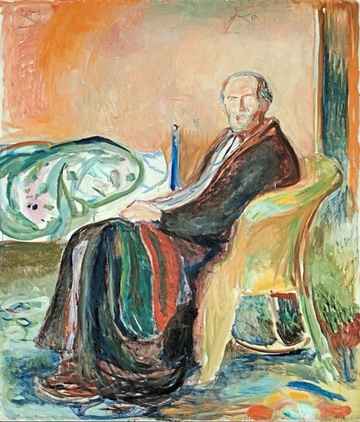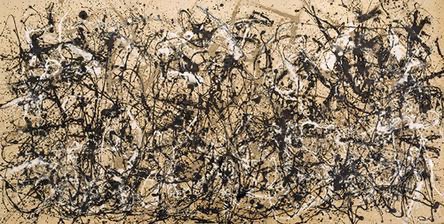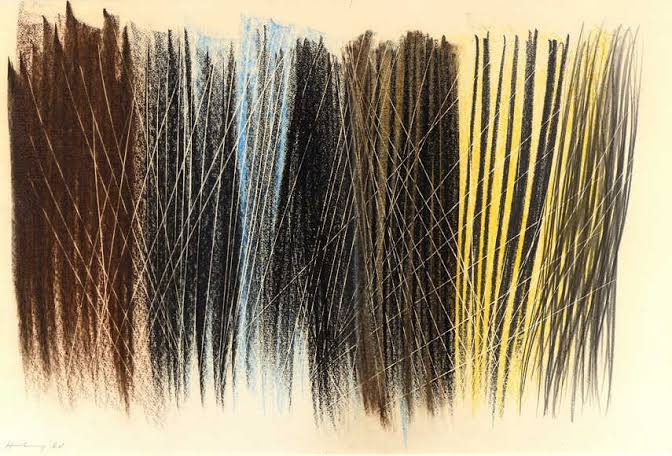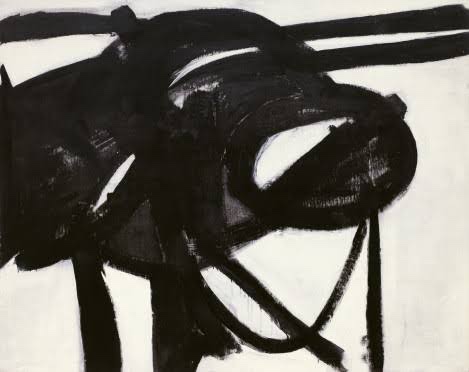RESEARCH POINTS
RESEARCH POINT 1
I have to look a a range of painting with particular attention to the way the paint has been applied – from Monet, Pissarro, Cèzanne, van Gogh and the Expressionist painters. I should also look at the work of some 20th century pastel paintings and make notes about the range of effects I find. The interesting idea that comes to my mind is that I am looking at the materiality of paints on artworks, but that I have access only through photo images, copies, on the internet or in books, or memories of works I saw in museums/galleries. I need to keep in mind that these works were made through the use of art materials, which has a unique role in the making process, due to the fact that artists can manipulate these materials. (from UVC1 I remember Clemence Greenberg as an art critique who defended the materiality and process) I have to articulate the tactile qualities of the artmaking process of these works – the way the artist physically engaged with paint and constructed with it. Wassily Kadinsky asserted that artists articulate emotions through the materials in their work. When I look at Expressionism I try to think of the process through which these artists brought their works into being – ‘materialise” them with their paints, supports, solutions, their tools and brushes, their ideas, their concepts, their own history and knowledge of art theories (Chevreul’s colour theory and colour perception) their ideas about reality and their own emotions.
As a movement in the history of art, Expressionism first emerged in certain late forms of Post-Impressionism, which appeared during the final two decades of the nineteenth century. For Expressionist artists physical reality became less as they sought to express the meaning of emotional experience. These artists rejected traditional realism and instead focused on spontaneous brushstrokes, vibrant colours, and subjects taken from newly modernized life. The Impressionists experimented with colour using a more optical method, mixing unblended pigments to create a nebulous blend of pure color. They worked with short, hurried brushstrokes, as they worked quickly outdoors. So the fact that they were working outside changed their methods. Impressionists also explored the theme of isolation in a newly crowded society through their subject’s gaze, which rarely met those of others in the same scene. Similarly, artists would also add physical barriers, such as balconies and bars, between subjects in their composition.
Van Gogh (1853-1890) clearly revealed tendencies of the brush stroke, expression and the surface itself. His intentions was to articulate the experience of the space itself – he made swirling strokes to give form and he almost moulded the paint in his landscapes. Paint was used through Impasto and was energetic and expressive – brushstrokes give the impression of immediacy and almost being unrefined.
Paul Gauguin (1848-1903) strove to express his inner emotions on canvas, largely through the use of colour. I looked at a work of Gaugin’s , The Yellow Christ, 1889 – his depiction of Christ is idealized in terms of colour and form, and situated within a contemporary landscape (Breton women gathered around the cross) during what looks to be like evening time in autumn. It is full of flat planes and intense colours. There is also speculation that the Christ figure is very much to the likeness of Gaugin, who at that time, went through a very difficult personal time.

Paul Cézanne used heavy brush strokes during his early years and thickly layered paint onto the canvas. Rather than work from sketches he was influenced by Monet’s ability to create shapes on the canvas and applied colour with big, broad strokes. Cézanne used colour, not as an end in itself, but rather like line, as a tool with which to construct form and space. He was much influenced by Pissaro to move away from the dark colours and heavy earth tones in the spirit of Courbet which he had been using earlier. He used parallel strokes on the diagonal, some times 1 inch long, to create patches of colour. I read that contemporary accounts indicate this method of paint application as a slow and labored process requiring much thought; as one layer was applied richly over another it was often difficult for the artist to recognize a stopping point. Cezanne brought the surface to the front, where the masters up to then were using blending and glazes to create and model form.
“Indifferent to the textures of objects, Cézanne recreates in the more palpable texture of paint the degrees of materiality: the opaque, the transparent, the atmospheric, and the surface existence of the pictorial itself in the ornament on the papered wall – the shadow of a shadow, an echo of his own art.
“To define the forms in this unstable medium of air and light in which the colors at the contours merge with the surrounding tones applied in similar slanting strokes, Cézanne has drawn dark lines around the objects. More definite than in his other pictures, these outlines are not as uniform and thick as the enclosing lines that later artists derived from them http://www.artchive.com/theory/schapiro/frame1.html
Edvard Munch allowed his neuroses and physical ailments to permeate the cultural anxiety expressed in his work. Munch’s preoccupation with suffering in this self-portrait below is fully understood by those who study the Spanish flu pandemic which erupted during the last stages of World War I. This global disaster reinforced the era’s nihilism and apocalyptic visions of despair. “I had a little bird/Its name was Enza/I opened the window/And in-flew-enza,” morbidly sang the children as they skipped rope. I wonder how much of this has returned to our society now with Covid 19 declared a world wide pandemic. Scholars like the University of Texas’s Linda Henderson later suggested that the act of looking beyond surfaces, and recognizing the underlying instability of the world around us, greatly influenced artistic production at the turn of the 19th century and eventually lead to the birth of abstraction, particularly Cubism. I have recently also looked at the work of Marlene Dumas and a self portrait of her shortly after the death of her mother can also be included in this discussion. After my formative feedback from my tutor in the work done on this final part of the course my tutor referred to references I made to artists and suggested that notes on these would be good and how I could compare my painting style.

Below is a work by the German Expressionist, Ernst Ludwig Kirscher, Street, Berlin” (1913). One can see how the artist turned to lurid colour, gestural brushstrokes, and distorted subjects to channel intense, genuine emotions through the work – the colours had no relation to the subjects – pink tones of peoples faces as well as in the background around them, facial distortions that could relate to their modern lives in the city.



RESEARCH POINT 2 Learn about Abstract Expressionist, in particular, the style of painting called Tachism/Action Painting – artists such as Hans Hartung, Franz Kline and Jackson Pollock should be researched. I am reminded again of the influence of the New York School Group of artists, as well as the newly started MOMA in New York as well as many European artists, philosophers, intellectuals, who came to USA before and during the war and how these artists, living in close proximity influenced each other. Harold Rosenberg in 1952 , according to a Moma article, described “action painting” as the record of a dance like confrontation between artists and canvas.
I recently started a Postwar Abstract Painting course with Coursera and learnt about the background to Jackson Pollocks’ art practice in his earlier years. I understood that he was strongly influenced by a teacher, David Alfaro Siqueiros. In this teacher’s experimental workshop, techniques and materials were undertaken with working class materials, like enamel paints, stencils, spray paint, throwing and flinging paint. A main thing one sees developing is artists moving away from subject matter towards the act of painting, how the body moves, became part of the art of action painting. To execute this work, Pollock laid out a large unstretched canvas on the floor of his studio, and then, walking around the four edges of the canvas, he systematically poured, dribbled, and flung paint across its surface. In one of his rare written statements, Pollock explained, “When I am in my painting, I’m not aware of what I’m doing. It is only after a sort of ‘get acquainted’ period that I see what I have been about. I have no fears about making changes, destroying the image, etc., because the painting has a life of its own. I try to let it come through. It is only when I lose contact with the painting that the result is a mess. Otherwise there is pure harmony, an easy give and take, and the painting comes out well.”
Pollock’s drip paintings were dramatic in scale and almost as if declaring with it, that what he was creating was big in all manners of art! Abstract Expressionist paintings appear to be eminent examples of museum art, today an eight-by-eighteen-foot canvas is commonplace, and galleries and museums have long since adjusted their own scale to the demands of these works, with public taste enjoying it. In these gestural applications of paint, viewers can read the various rotations of his arm, his steps around the canvas, and the powerful snaps of his elbow and wrist.

Hans Hartung was a French painter of German origins. He was particularly well know for almost calligraphic arrangements of black lines on coloured backgrounds. he used a swirling style to paint with a loaded brush. These Tachist works are seen as more elegant and lyrical. One again see a more intuitive form of expression in these works, being more spontaneous.

When I look at these works and realize the intention of the artists to show the viewer the human action, there is also a feeling of being more aware of the inner thoughts of the artists at the moment of creation. It is as if the canvas became an extension of the artists mind and the canvas the object onto which these ideas came into life.
Frans Kline used spontaneity in his painting techniques and painting became much more a subjective experience. His work further more questions the idea whether interpretation was necessary or even possible. He used common housepaint brushes and worked mainly with a black and white palette. The qualities of painting , namely composition, color and brush strokes was the main reason for his work, and not so much his own feelings or emotions.

Viewers were challenged to interact with the marks and compositions themselves. His work was planned ahead of time, and not so intuitive.
Looking back after I did some reading on the work methods of the Abstract Expressionist artists, I realize the interesting tactile experience of applying paint onto a surface is such a wonderful experience. One should really recall how paint feels when its is impasto, compared to loaded with medium and or oil, or very dry. The way your hand, or knuckle rotates with the brush will be so different. Application of paint by the way the body moves became an awareness; there is gestural and actions involved. Iam thinking about how, by changing the canvas around, or painting with your left hand, if you’re right handed can also contribute to different gestural marks.

Bibliography
P Gaugin The Yellow artist. https://www.musee-orsay.fr/en/collections/works-in-focus/painting/commentaire_id/the-artist-with-the-yellow-christ-2048.html?tx_commentaire_pi1%5BpidLi%5D=509&tx_commentaire_pi1%5Bfrom%5D=841&cHash=78d69b47ec
Curley, John J, Spotlight Essay on Willem de Kooning, Website accessed in April 2020. Kemperartmuseum.wustl edu